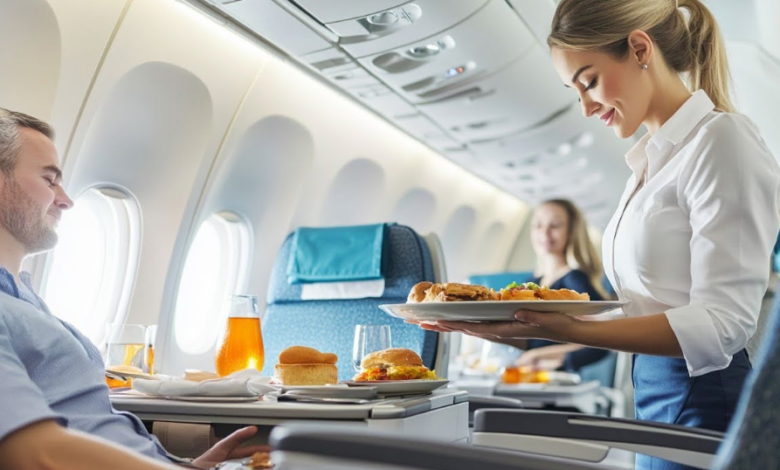Behind the Scenes: The Logistics of Inflight Catering Services

When passengers board an aircraft and enjoy a perfectly presented meal at cruising altitude, few stop to consider the intricate process that made it possible. The world of inflight catering services is a complex blend of precision planning, international regulations, time-sensitive deliveries, and culinary artistry. From sourcing fresh ingredients to ensuring food safety at 40,000 feet, every step is carefully orchestrated behind the scenes to create a seamless dining experience.
This article takes you into the hidden world of inflight catering, revealing the systems and expertise that ensure passengers enjoy exceptional meals in the sky.
The Foundations of Inflight Catering Services
Inflight catering isn’t just about cooking meals—it’s about creating menus that work within the unique constraints of aviation. Dishes must be prepared in advance, stored at safe temperatures, transported to the aircraft, and reheated or plated onboard without losing their flavor or texture.
Inflight catering services often start planning days or even weeks before a flight. For regularly scheduled services, there’s a consistent menu rotation. For private charters or VIP flights, caterers design bespoke menus tailored to passengers’ tastes, dietary needs, and cultural preferences.
Step 1: Menu Planning and Ingredient Sourcing
Before any cooking begins, catering teams coordinate with airlines or private jet operators to finalize menu selections. This involves:
- Understanding passenger profiles: First-class and business-class passengers may have higher expectations for variety and quality.
- Accommodating dietary needs: Special meals (vegan, gluten-free, kosher, halal) require careful sourcing and preparation to meet strict standards.
- Selecting aviation-friendly dishes: Certain ingredients or textures may not perform well in the dry, pressurized cabin environment.
Ingredient sourcing is equally important. Freshness is critical, so caterers work with local suppliers near airports to minimize transport time. For long-haul flights, some ingredients may be imported to ensure authenticity—such as French cheeses, Japanese wagyu beef, or Middle Eastern spices.
Step 2: Food Preparation and Assembly
The preparation process takes place in specialized catering kitchens located near airports. These facilities are designed for high-volume, high-precision work and meet strict hygiene standards.
Key features of inflight kitchens include:
- Separate preparation areas for raw and cooked foods to prevent cross-contamination.
- Blast chillers that rapidly cool freshly cooked meals to preserve taste and safety.
- Vacuum sealing and portioning equipment to maintain freshness during transport.
Catering chefs prepare dishes to about 90% completion—this is known as “par-cooking.” The final cooking or heating happens onboard the aircraft so the meal reaches passengers at peak quality.
Step 3: Packaging for Flight
Once meals are prepared, they’re carefully packaged for air travel. Packaging is more than just convenience—it must meet specific aviation requirements:
- Space efficiency: Airline galleys have very limited storage space, so containers must stack neatly.
- Durability: Packaging must withstand turbulence and temperature changes.
- Food safety: Meals are sealed to prevent contamination and labeled with preparation and expiration dates.
In premium cabins, meals might be pre-plated in elegant dishware, while in economy class, food is often portioned into heat-safe trays.
See also: Arcade Video Game New Orleans: 19 Must-Experience Spots for Nostalgic Gaming & Nightlife
Step 4: Transporting to the Aircraft
The logistics of delivering catering to aircraft is a finely tuned operation. Most inflight catering services use specialized high-loader trucks that can elevate to the aircraft door. These trucks are refrigerated to keep meals at safe temperatures during transit.
Timing is critical—meals are typically loaded just before departure to maximize freshness. This process must also coordinate with aircraft cleaning, fueling, and boarding schedules to avoid delays.
Step 5: Onboard Handling and Service
Once onboard, flight attendants or inflight chefs (on private or luxury flights) take over. Their role includes:
- Storing meals at correct temperatures until service.
- Using galley ovens, steamers, or induction cooktops to heat food.
- Plating and garnishing dishes for presentation.
Because cabin air pressure and humidity affect taste perception, inflight menus often use slightly bolder flavors to ensure dishes remain satisfying at altitude.
Challenges in Inflight Catering Logistics
Delivering fresh, safe, and high-quality meals in the aviation environment comes with unique challenges:
- Time Constraints: Catering must be delivered in narrow windows between aircraft arrivals and departures.
- Security Requirements: All catering equipment and staff must pass airport security protocols.
- Unpredictable Delays: Weather, air traffic, or last-minute passenger changes can disrupt schedules, requiring quick adjustments.
Technology’s Role in Streamlining Operations
Modern inflight catering services rely heavily on technology to coordinate their complex operations. Examples include:
- Inventory management software to track ingredient usage and reduce waste.
- GPS tracking for catering trucks to optimize delivery routes.
- Digital menu systems for easy updates and passenger customization.
- Temperature monitoring devices that ensure food safety during storage and transit.
These tools improve efficiency, reduce costs, and enhance consistency—essential in a business where timing and quality are everything.
Sustainability in Inflight Catering
As environmental awareness grows, many catering providers are taking steps toward greener practices:
- Reducing single-use plastics by switching to biodegradable or reusable materials.
- Minimizing food waste through better forecasting and portion control.
- Sourcing local and seasonal produce to reduce transport emissions.
Some airlines even partner with sustainable farms and fisheries, bringing eco-conscious dining to the skies without compromising on quality.
The Human Touch
Behind all the technology and logistics, inflight catering services remain a people-driven business. Chefs, kitchen staff, logistics coordinators, and flight attendants work together to create a smooth dining experience for passengers. Their skill, attention to detail, and adaptability ensure that even in the unpredictable world of air travel, passengers can enjoy a meal that feels effortless and elegant.
Conclusion
From farm to fork at 40,000 feet, the journey of an inflight meal is an extraordinary feat of coordination and craftsmanship. Inflight catering services blend culinary expertise with logistical precision, ensuring passengers enjoy safe, delicious, and memorable meals no matter where they’re flying.
The next time you’re served a perfectly plated dish in the air, you’ll know it’s the result of a carefully managed process involving dozens of steps, hundreds of people, and a






